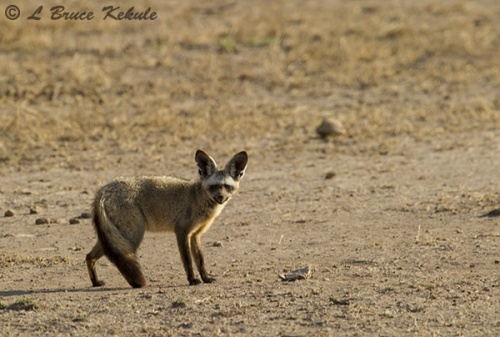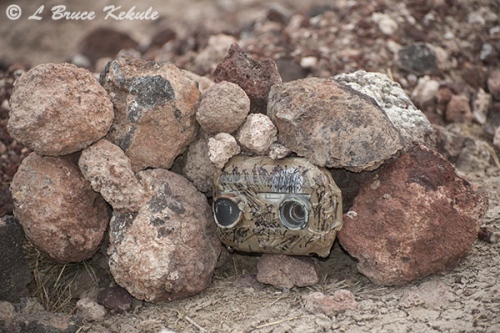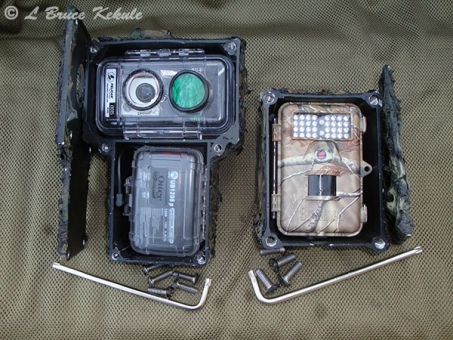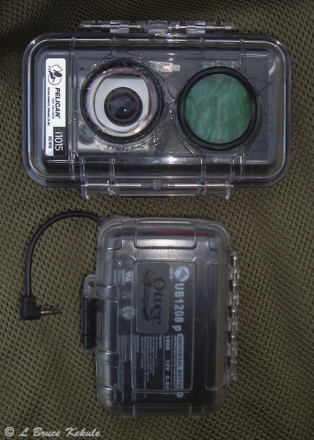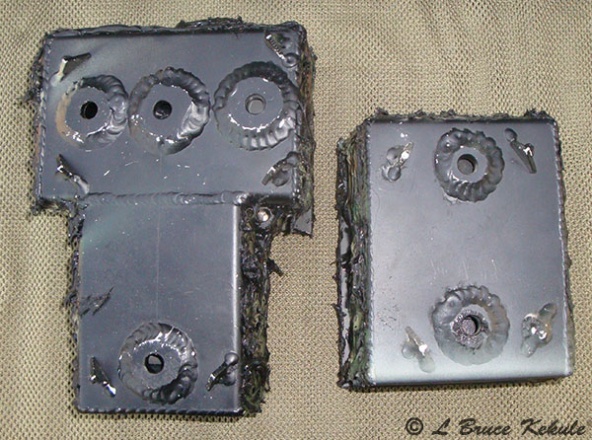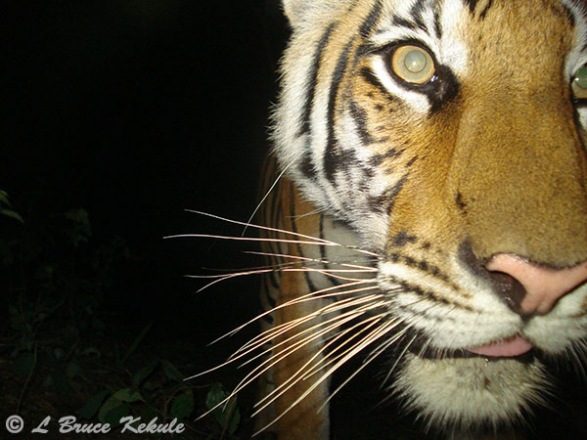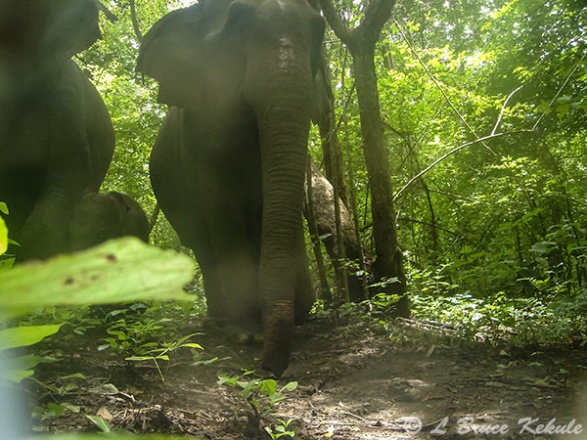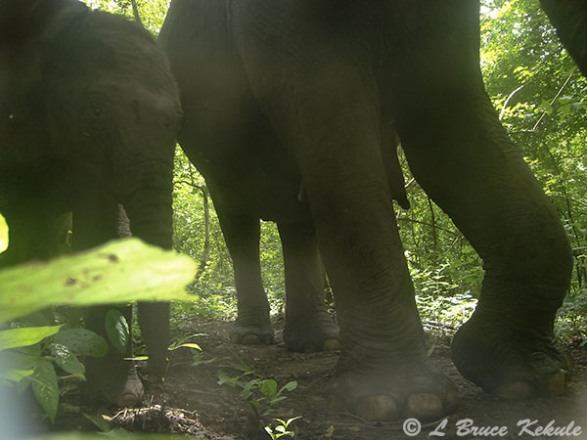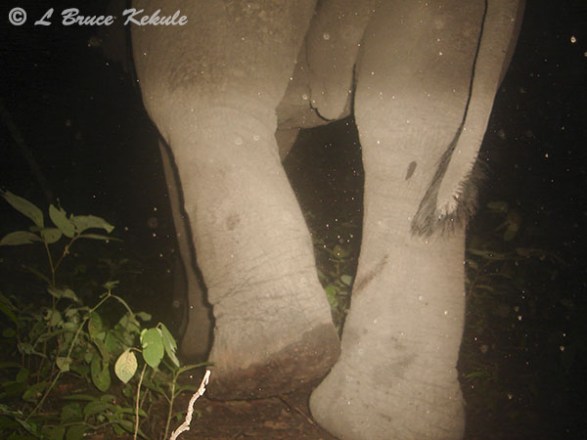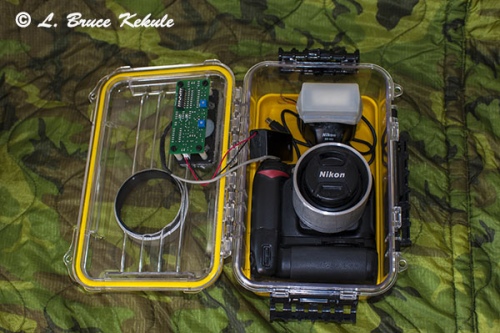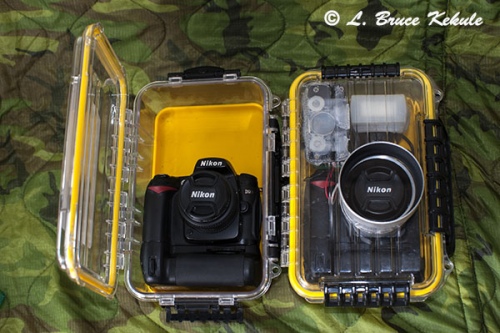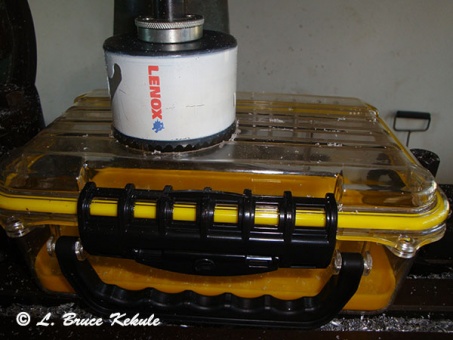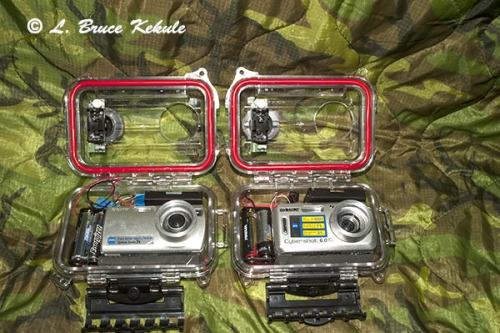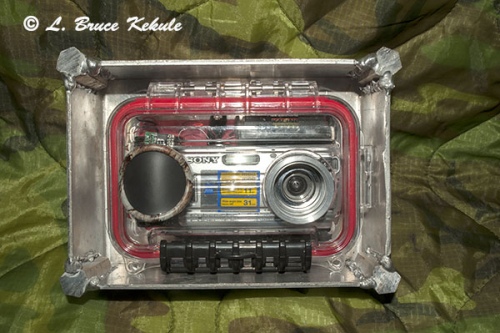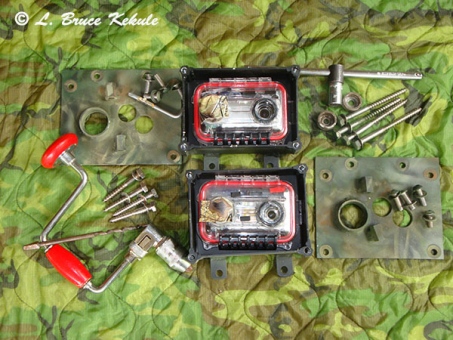Posts Tagged ‘infrared camera-trapping’
Africa Series: Sony S40 catches bat-eared fox
A camera trap’s final stint at a fox den in Amboseli National Park, southern Kenya
Bat-eared fox cub in its den
I took a Sony S40/Plano 1449/SSII/4 double AA externals to southern Kenya in December 2012 to be used in quick set-ups with minimum security (no Python locking cable) mainly to be used by the side of the road. The first location was Amboseli National Park near Mount Kilimanjaro where I captured a rare carnivore: a whole den of bat-eared foxes.
Bat-eared fox adult just outside its den
As me and my driver/guide Patrick Njoroge were on game drive, we noticed two adult foxes running away from their den that was about 10 feet from the road. I got some nice shots of the adults in great light. I decided to leave the cam overnight in some rocks near the ground as the site looked promising.
The other mature fox in the afternoon
While setting up the cam, I heard the pups in the den and one of them actually barked at me. I sat in the truck and waited, and in a few minutes a young one popped its head out shown in the lead photo. I had a great time shooting the little carnivore with my Nikon D3s/600mm.
Fox family checking out the S40
We left shortly thereafter so as not to disturb them and let the home-brew do its work. That night, two adults and four cubs were caught by the S40. The next morning I was elated to see that this family was surviving in Amboseli. I downloaded everything from the card immediately. It’s a good thing I did too…!
Getting closer and not afraid of the flash
Later that day we moved to Tsavo West National Park situated east where I previously had set-up a Bushnell Trophy Cam at a waterhole deep in the park. With no cable, the S40 attached with tape was vulnerable but I thought who would steal a cam way out here. Boy, was that ever a big mistake. That night, a hyena came and took the S40, and the Bushnell recorded it all as seen on my previous post ‘Bad Hyena Night’.
Even the cubs are not afraid
It’s hard to believe an African hyena would actually take my cam. Somehow, the creature must have been attracted to the salt residue left by my hands is the only explanation I have. The next morning on our way out, we looked around but could not find it. We left but I accepted the fact the S40 was gone but it had done a brilliant job of catching the foxes and that was that…!
My favorite S40 shot
I wonder where the S40 is now? Could it be down the hyenas den still tripping? Is it a chew-thing for the hyena cubs? I will never know.
Sony S40 camera trap set in rocks by the road at bat-eared fox den
The moral of this story; whenever you can, always download your card or you could loose a lot….!
Enjoy.
Bad Hyena Night
This is what happens when you get lax….or was it just an oversight…? Needless to say, I lost my great little Sony S40 cam in a Plano 1449 and SSII with double AA externals to some tenacious hyenas. It was a great little cam and took good photos. And yes, it was the S40 hacked by Joe 12-Ringer I won in last year’s camera trap competition held by Camtrapper.com. I took this homebrew to Kenya as a quick-setup cam mainly to be used by the side of the road and hence, there was no ‘Python’ locking cable. Unfortunately, I also lost a whole bunch of photos that the cam took because I used some sticky tape to hold it in position above a Bushnell Trophy Cam. The rest is history.
PS: I do have two spare S40s with boxes and sensor boards that will be built some time in the near future. They are great little cams…!
Go Pro trail cam – Bushnell companion cam
Homebrew video trail camera and commercial back-up:
Early this year, I acquired a Go Pro Hero 2 wanting to build a daytime HD video cam for a certain tree and a long soak at my favorite workplace; Huai Kha Khaeng Wildlife Sanctuary in Western Thailand.
I also had a 2011 Bushnell Trophy Cam ‘Bone Collector’ that takes quite decent IR clips, and would set it up next to the Go Pro. The Bushnell could also be used as a security cam set to video watching over the Go Pro from a hidden position.
Visited by tiger and leopard, a huge tree at a mineral deposit deep in the forest is perfect for these cams. A myriad of other species also come down to this waterhole during the daytime like wild cattle, bears and deer, and is a sure bet for some good videos, specially during the dry season coming up.
The first order of business was what case would I use. While shopping at an outdoor supply company, I found a unique Pelican i1015 meant for an iPhone or iPod with a stereo plug inside the case with an external jack. The Go Pro and SSII board fit with room to spare. A 40.5mm UV filter and HPWA lens are attached to the case with ‘Goop’.
I also wanted an external power source and picked up a 12v SLA #UB1208p battery that fits perfectly in an Otter 1000 case. Being modular would allow different external power supplies to be used. I cut the wire in the i1015 and attached it with ‘Goop’ to the battery case. Alternative externals can be 3 18650 4.2v lithiums.
In the meantime, I sent the camera to fellow Camtrapper.com member ‘TRLcam’ to be hacked, and then visited Gary at Snapshotsniper in Oklahoma where I purchased a few of his excellent SSII boards programmed for the Go Pro.
After consultations with TRL, a 12v to 5v USB adapter was used as the easiest way to connect the 12v battery to the Go Pro.
Everything was put together and I made up an ‘elephant proof’ aluminum box with 8mm ‘power torque’ machine screws designed for the Pelican in the horizontal position, and the Otter in the vertical position. Another box was built for the Bushnell.
3D camo is made up using industrial black silicon sealant and painted with several shades of camouflage in khaki, green and brown using bamboo leaves. Simple but effective.
Security will be four 3/8” X 3” stainless lag bolts and two ‘Python’ 3/8″ locking cables for the Go Pro, and two lags and two 5/16″ cables for the Bushnell.
Both cams will be set in a week or so, and ‘setup’ and videos will be forthcoming.
I would like to thank TRLcam for his help and advice, and to Gary for the boards.
Hope this helps those interested in building a Go Pro. I might make-up an IR unit at a later date to work in parallel with this one but will have to study the components and plans first. They certainly are great little cameras…!
UPDATE:
The Go Pro attached to the Snapshotsniper SSII board will not work without the following modification:
A PN2222 resistor and a 10K transistor installed as shown is required to control the Go Pro.
Photogenic Indochinese tiger
This series of camera trap images of a young tigress was collected in Huai Kha Khaeng Wildlife Sanctuary with a Sony W55 homebrew trail cam during May of this year. This particular tiger does not seem bothered by the flash and I have caught her several times prior to this set. Some animals don’t mind flash while others do. I have a tiger on video growling and back-tracking after seeing the red-LEDs on a Bushnell Trophy Cam. I tend to believe it all depends on the individual animal.
Note the wound on her left flank and ticks in her ears.
A wild elephant’s foot…!
All images by a Sony S600/S40 camera trap
Wild Asian elephant herd checking out my camera trap
The toughest test of a camera trap in Thailand’s forest is being attacked by the awesome power of a wildlife elephant. These huge beast are very inquisitive and will check-out anything that catches their eye. Camera traps are of special interest and depending on how tight the cam is on the tree, these giants will try to rip it off. The following sequence was captured last month.
Mother elephant and baby
Elephant’s rear end
Female elephant showing tushes
Elephant’s muddy foot
Another ‘mud paw’
They tried in vain to get my cam off but it was so low, they could not get any leverage so they just used their muddy ‘paws’ but failed. However, the lens and sensor were covered in mud after this. The last few shots show what an elephant’s foot looks like…!
Special interest:
This shot of a very old, old banteng bull with a damaged pair of testicles was earlier on the same setup before the elephants. No telling what happened to this poor guy. He was probably evading a predator and scratched em’ on a stick while bolting through the forest. There are big tigers here that go after the old bulls…!
This bull is very old judging from the hang on the dang….!
Indochinese tiger camera trapped in Huai Kha Khaeng
An Indochinese tiger with a radio collar around its neck.
A big cat camera trapped in Huai Kha Khaeng Wildlife Sanctuary, Western Thailand using my BFOutdoors’ camera trap with a P43/1040/two ‘C’ cell externals.
There is an on-going scientific survey following some eight tigers in the sanctuary gathering data on their range and behavior. It has been proven in India that tigers with collars do not breed well and hence, I’m not too convinced the program is viable at this location. Also, the data on tiger numbers is not shared with the general scientific community and kept highly secret by a few individuals and an international conservation NGO. It is hoped that one day these collars (which must be very uncomfortable) will be removed to allow these magnificent cats to carry out their lives naturally.
LBK ‘Clear-view’ Nikon DSLR camera trap
Nikon N90s/Nikon SB400/Plano 1460/ Yeticam sensor board
A new DSLR homebrew camera trap in the make-up phase
When I began shooting wildlife with a camera some 16 years ago, I chose Nikon because of several reasons but rugged camera bodies and great lenses were the main factor. I’ve always been partial to this brand. However, after horrible Nikon service here in Thailand run by a local tyrant, I switched to the Minolta brand in film and then Konica-Minolta in digital. After they went belly-up, I went back to Nikon and fortunately the mother company from Japan is now running things here in Thailand including excellent service.
I picked up two D90s that is reasonable in price and very good for quality images. A couple of generic battery packs were purchased and use two Nikon EN-EL3e lithium batteries in each. I had some old ‘Yeti’ boards and ordered two “EOS” chips from Mark over at Yeticam.com. This is my first homebrew DSLR using a Nikon and I chose a 50mm lens for this rig. With a 1.5-factor, the lens is comparable to a 75mm that is OK for frame filling shots that I prefer for camera trap images.
Both units ready to be completed
While in the States recently, I found some Plano ‘Guide Series’ # 1460 cases at Dick’s Sporting Goods up in New York that looked perfect for a DSLR cam. I bought two in clear as my plan for this cam was to use a small Nikon SB-400 flash shooting straight through the case and activating some remote slaves. A flash diffuser will be used to soften the flash. By using the flash on the hot shoe, precise TTL metering can be had and the slaves are used for fill lighting.
The snorkel is made from aluminum tubing and these will be anodized and then ‘Gooped’ in. A 77mm circular UV filter with a hood is attached. Due to limited space the Yeti board is installed in the vertical position to allow for precise triggering.
Machining case for the lens snorkel
As soon as possible, ‘elephant proof ’ aluminum boxes will be built to house these two cams. Due to the size of the box, I will be incorporating angled plates on the top and sides to keep elephants from getting a grip. Four 3/8” x 3” stainless steel lag bolts will be installed from inside the box and 4 to 6 10mm ‘power torque’ machine screws will close the faceplate. A heavy-duty 10mm (3/8”) Python locking cable will also be used.
When these are finished, I will post photos of the complete builds. In the meantime, remote slaves will be acquired and aluminum boxes will be built for them too. The main reason for this build is improved image quality. Hope this helps any budding DSLR homebrew builders…!
More LBK ‘Clear-view’ camera traps
Sony S600-S40/Plano 1449/SSII/4 AA externals homebrew cams
This year’s competition in Camtrapper.com was great and really a challenge to make a winning shot. I was surprised to see my ‘Needle in the Haystack’ leopard actually place and when all the winners took their prizes according to their rating, I was left with a Sony S40. I felt extremely lucky to win this cam hacked by Joe 12-Ringer and waited patiently to get my prize, as I have never have had one and wanted to use it for a homebrew.
Sony S40 and S600, Plano 1449 case, Snapshotsniper II boards and 4 AA externals
While I was in the States recently, I visited Dick’s Sporting Goods store in Albany, NY. It took me awhile, but I eventually found some Plano cases Model 1449 that looked perfect for camera traps. I liked the clamp that looked strong, and the seal was nice and soft for a watertight seal similar to rope seal. The case looked plenty strong and the internal dimensions would allow two twin-AA externals. With Gary’s SSII, I can get everything in with room to spare. A snorkel was machined from 3/16” thick aluminum tubing.
Ready for final assembly
While I was in the U.S., I had several cameras working in the forest here in my usual locations including two Sony S600s/1020s/SSIs with security tubes. These had elephant proof boxes with Python locking cables and two 3/8” Stainless lag bolts at the bottom of the box but one was in a very low down set-up. An elephant found it and decided to give it a whirl. The giant managed to bend the bolts 90 degrees and finally dislodged it from the horizontal tree and stepped on the cam breaking the glass. The 5/16” ‘Python Locking Cable’ however survived the ordeal.
S600 unit in a ‘elephant proof’ box
Fortunately, the S600 and board is still working so I decided to build another cam using the S600 and the 1449 (same set-up as the S40 above). Machining the cases for the snorkel and the HPWA is pretty straightforward. I have begun making the ‘elephant proof boxes’ which need further work but will get these done just before my next trip into the forest. I will up-date this post with pictures when these are done.
Machining S40 faceplate
Finished S600 faceplate painted with primer
Camouflage painting both cams
Finished S600/S40 cams ready for the field
Both units setup on a fallen tree on a game trail
Chasing a Wild Dream
A video about Thailand’s Amazing Wildlife in the Western Forest Complex. From wild elephants to green peafowl, this film shows the world the wildlife in the Kingdom’s protected areas, and the need to save this wonderful natural heritage for present and future generations to come.
In the heart of Southeast Asia, the Kingdom is blessed with some of the best and last remaining examples of Asian animals and ecosystems that harbor the tiger, leopard, elephant, gaur, banteng, wild water buffalo, tapir, sambar, muntjac, gibbon, green peafowl, hornbill, plus thousands of other amazing creatures and biospheres that have evolved over millions of years and show-case Mother Nature and her magnificent beauty…!



